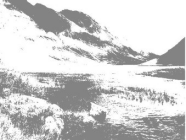

Main Page A Brief History Tracking the Monarch Our Accommodation Local Scenery Finding Us
TRACKING DOWN THE 'MONARCH OF THE GLEN' ON THE OLD ROAD TO SKYE


In July 1544 South Laggan was the scene of one of the fiercest clan battles in Scottish history - the Battle of the Shirts....Should you want to shudder at the thought of such violence, a plaque has been laid to commemorate this historic event in more detail. If you prefer to quickly move on, you can cross a nearby swing bridge to enter Glengarry. More reminders of this area's dramatic past are to be found only half a mile further on, in a place known as the 'Well of the Seven Heads'. You would be right to think of heads without bodies - the 'Well of the Seven Heads' earned its name from the Keppoch murders, one of the gorier inter-clan incidents.
Looking across Loch Oich, part of a string of Lochs and Canals that link Scotland's east and west coast through the Great Glen, one can still see the track bed of the former Spean Bridge/Invergarry/Fort Augustus railway, which was closed in 1946. Beside it are remnants of a far older route....that of General Wade's road, which linked Fort Augustus and Fort William 200 years earlier.
The ruins of the former stronghold of the MacDonells of Glengarry, Invergarry Castle, stand inside the entrance to the Glengarry Castle Hotel. Once the seat of the MacDonell chiefs, the castle was ruined by the 25 year old son of King George II, the Duke of Cumberland (later to be known as the Butcher of Cumberland). He then wreaked his revenge on the Highlands, in particular at the Battle of Culloden Moor.
The village of Invergarry can be reached by turning left off the main Fort William to Inverness road (A82) and heading west on the Road to the Isles (A87). It is interesting to note that the village is a classic example of a Victorian planned village. Such town planning came about largely as a result of the efforts of the Ellice family, who made their fortune in the Hudson Bay Company and other interests in America and Canada.

The schoolhouse, laundry, bank cottage and the hospital still remain, although they are all now private dwellings. The school is still in use, and local residents still talk of the Old Glass Factory, saw mills, gas works and smithy which they knew. Most of the cottages are now listed buildings, thus preserving much of the traditional character of Invergarry. Date stones can be seen over the lintels or at the gables ends of many of the buildings.
Leaving the village, one passes the store and old corn mill, dating from circa 1800, then the former factors house (now a guest house). Three miles further on, the road to Tomdoun and Kinloch Hourn leads off west along the shores of Loch Garry. You then reach Loch Quoich and Loch Hourn. Loch Hourn is actually an inlet of the Atlantic Ocean and is reminiscent of a Norwegian Fiord. This whole Glen is 22 miles long - the longest cul-de-sac in the UK!
Glengarry and the surrounding area was once home to some 5000 people - but the Highland clearances changed all that forever. Tomdoun was once the junction of the main road to Skye, until the massive hydro schemes of the 1940's changed the landscape. Experienced hill-walkers still like to traverse the the old route to the 'Misty Isle', as well as go in the opposite direction, into Glens Dessary, Pean and Kingie, travelling through the most remote parts of the UK, before meeting civilisation at Inverie (even then they have to use the thrice-weekly ferry to Mallaig!).
In the 1950's Loch Quoich was the scene of a most dramatic change of landscape. In order to accommodate a hydro-dam, the waters of the Loch were dammed, which raised them by 100 feet. Among the many settlement casualties was a very fine mansion,'Glen Quoich Lodge', which was stripped of its copper and lead before being fired and left to its watery fate. The house was visited by several notable personages, including Sir Edwin Landseer, sculptor of the lions of Trafalgar Square in London. Indeed, it is suggested that he found inspiration for his famous painting of a stag,'Monarch of the Glen', from Glengarry!
Unfortunately, death duties led to the break up of the estate in the 1930's, but luckily the development of forestry, followed by increased tourism and fish farming has contributed to the maintenance of the somewhat cosmopolitan 500-strong population.